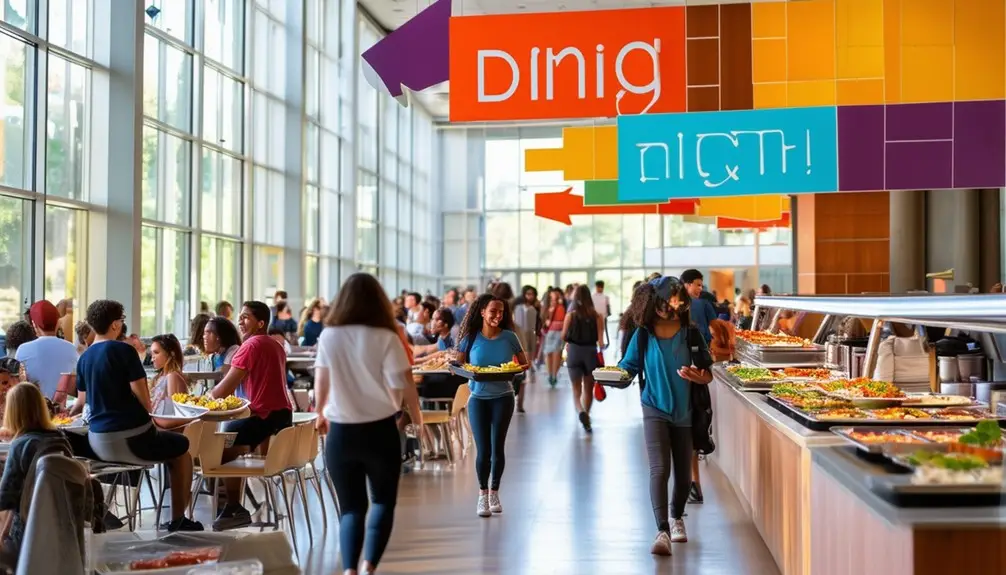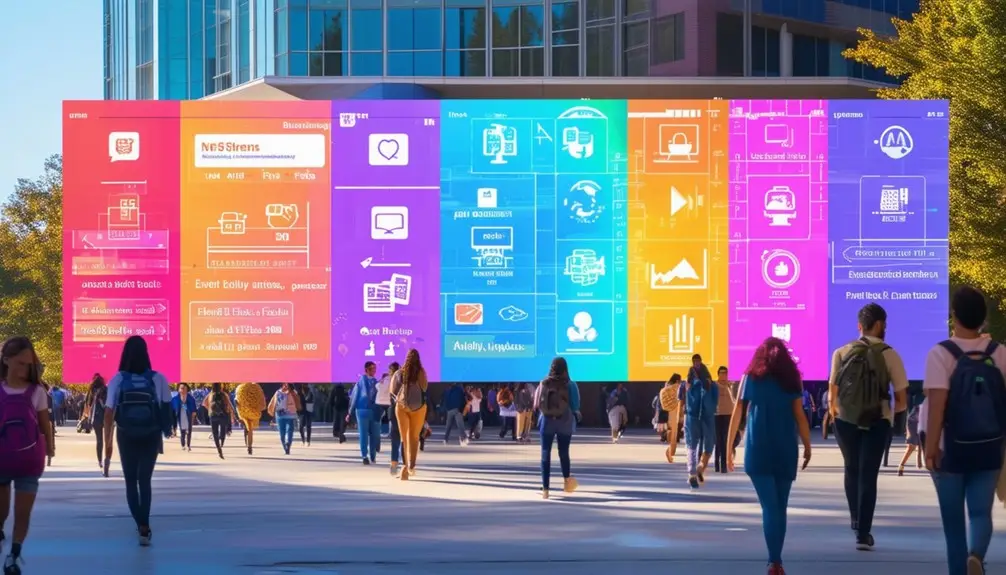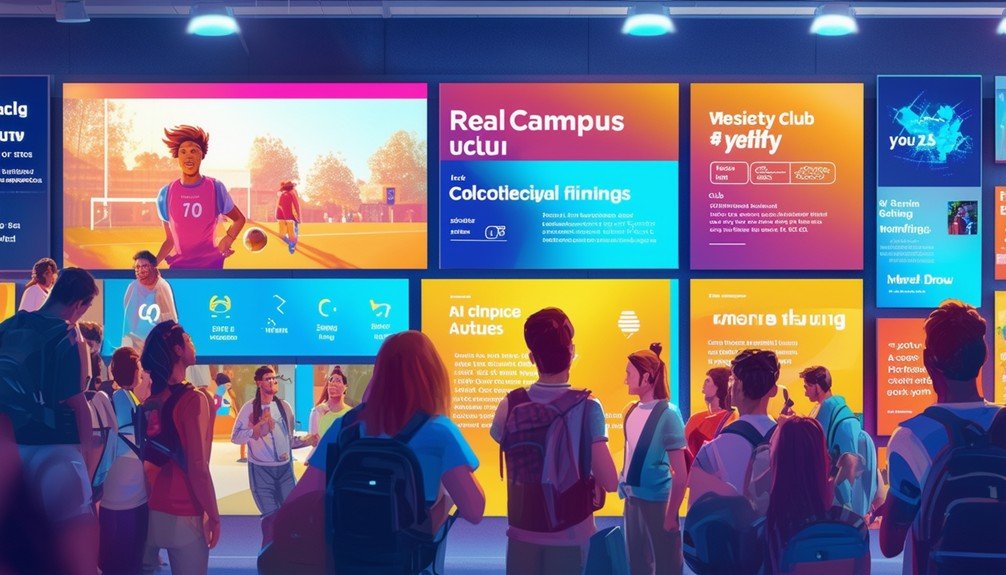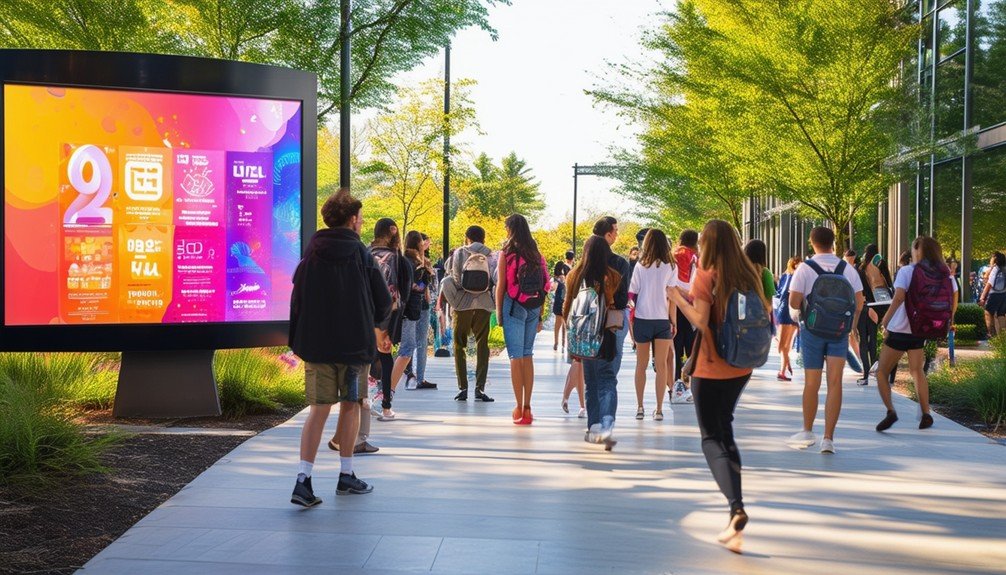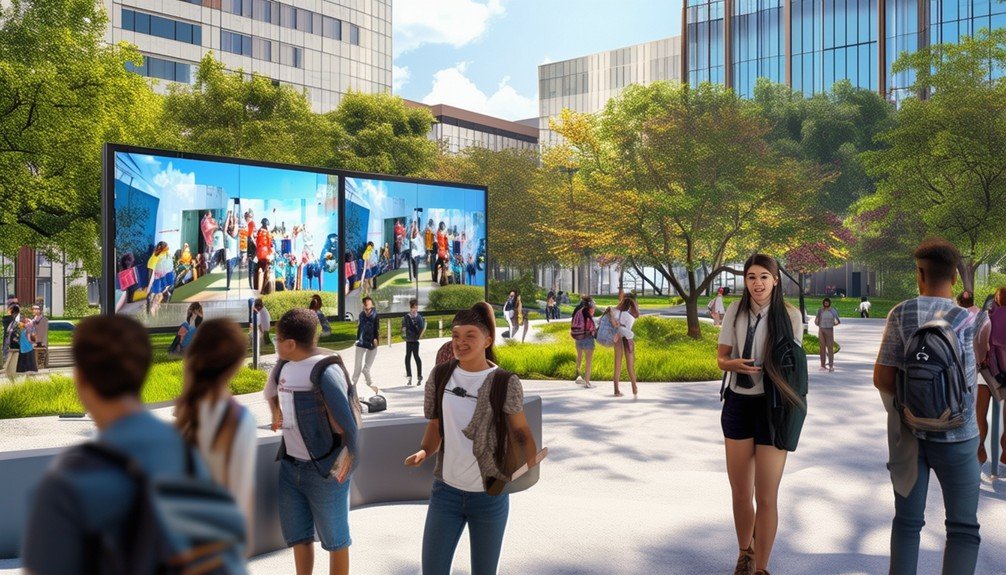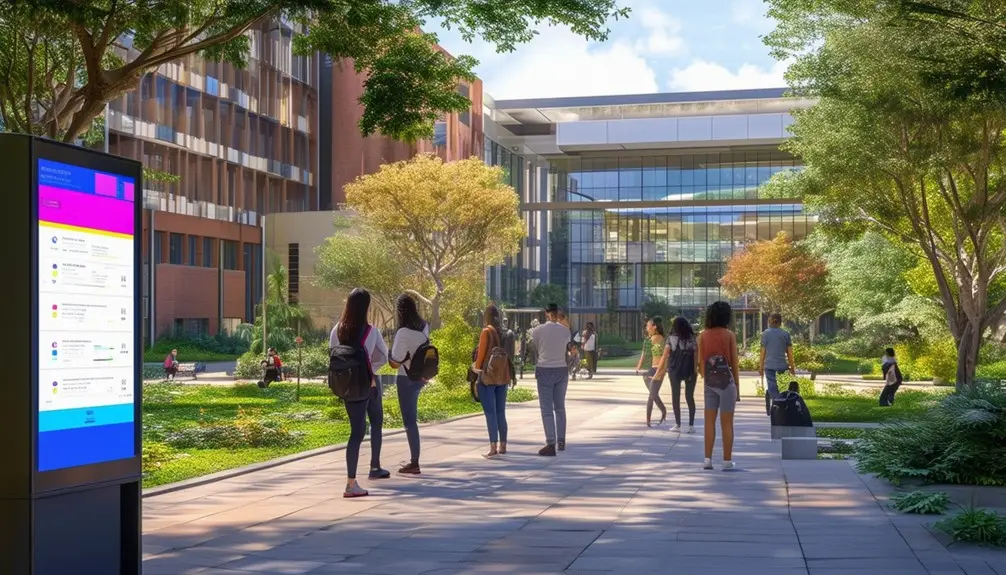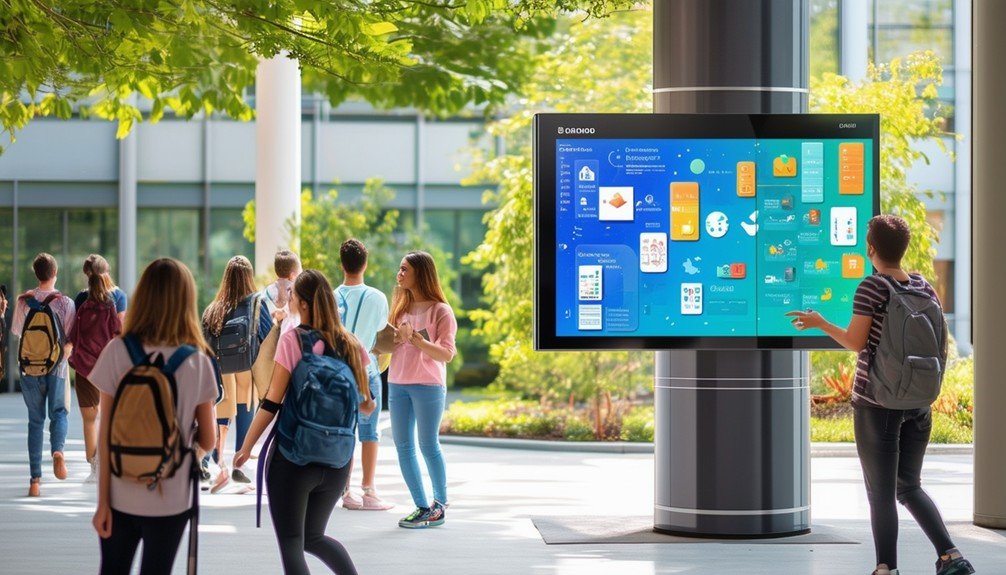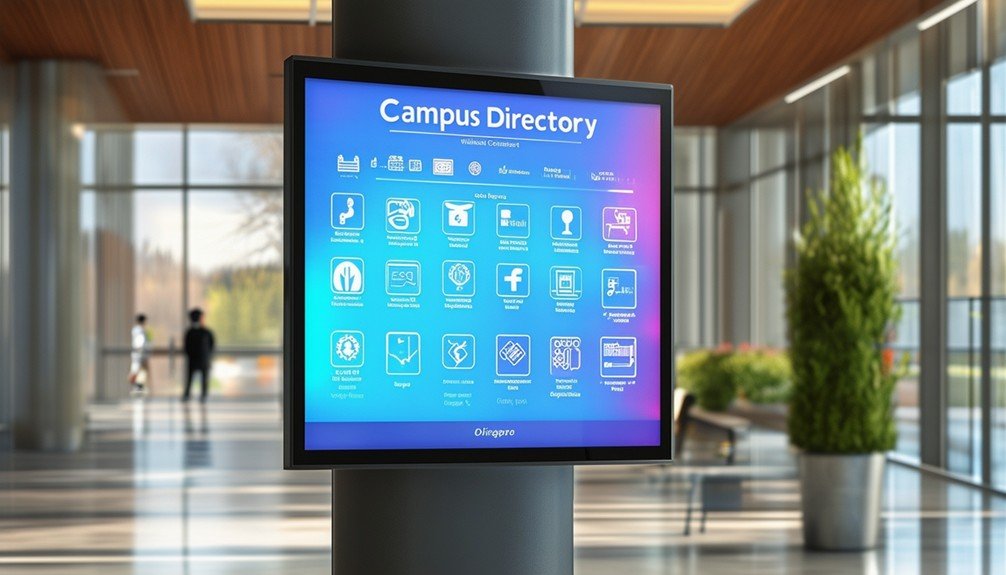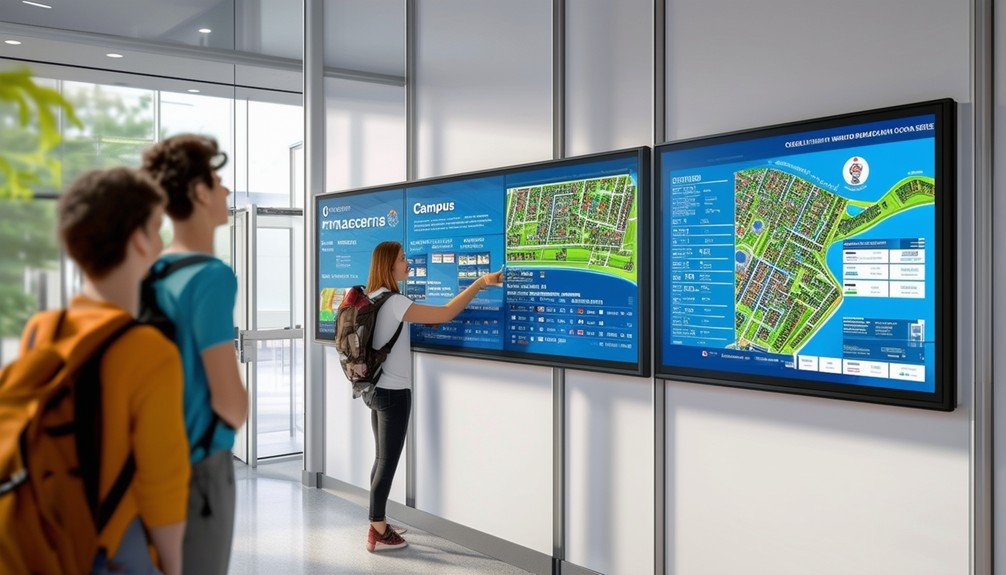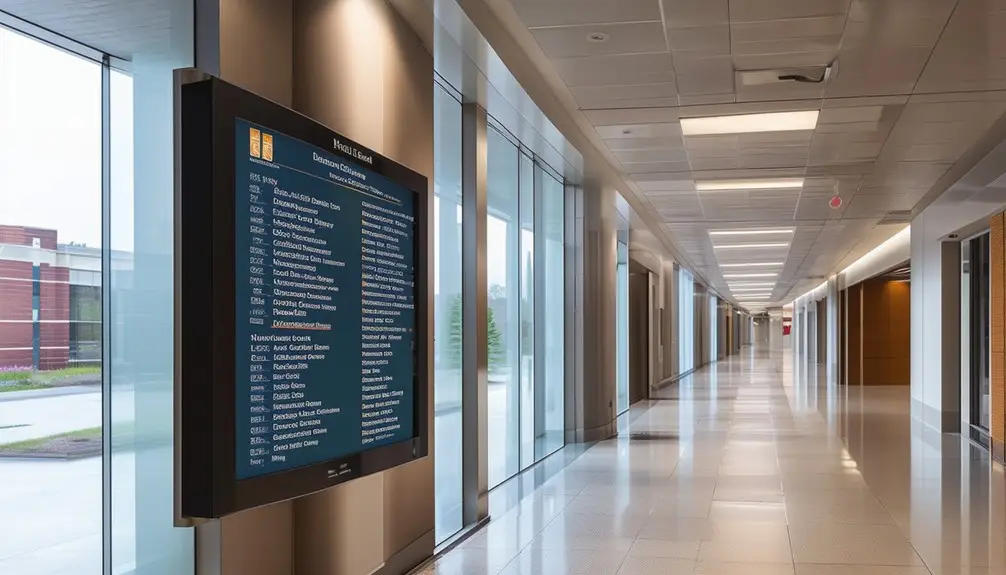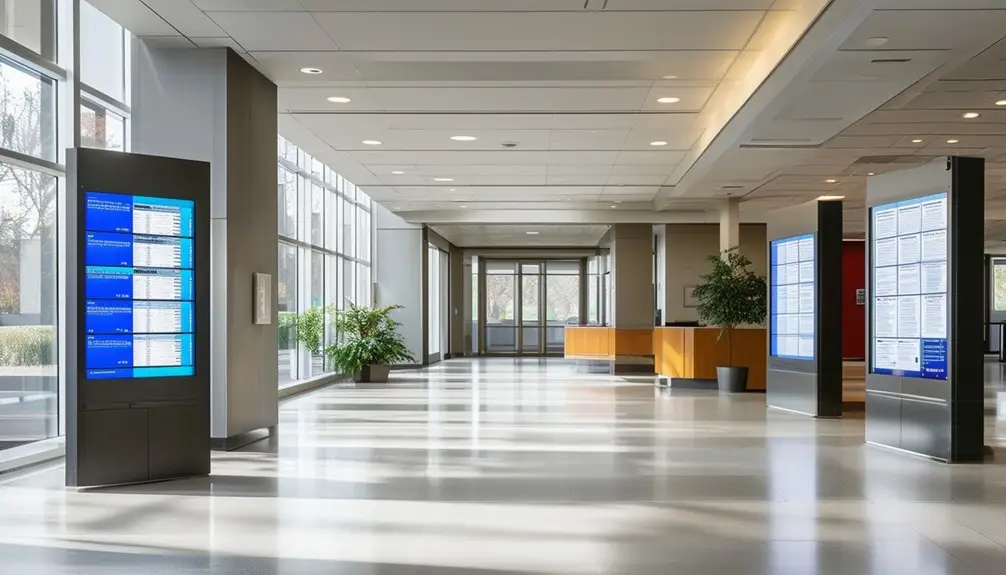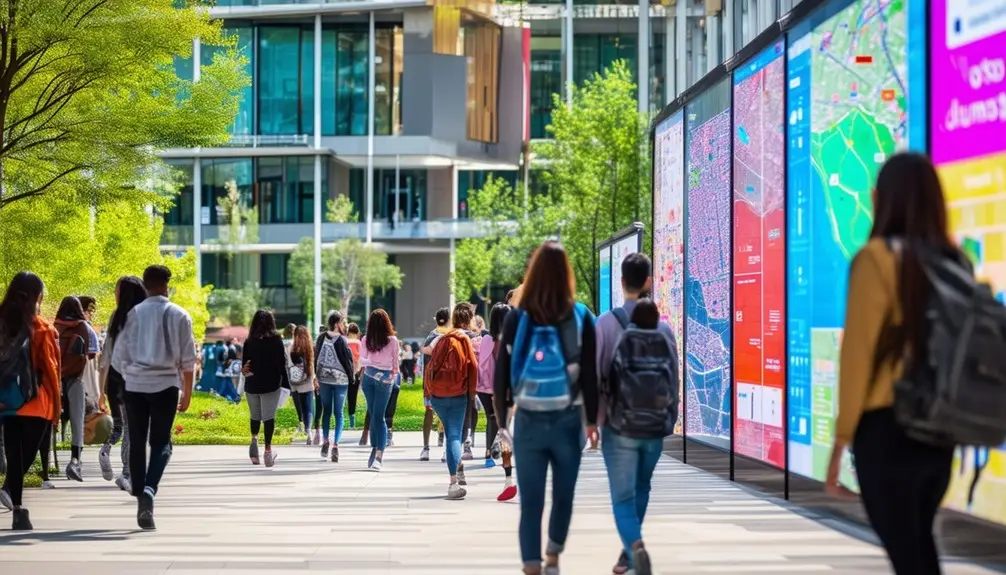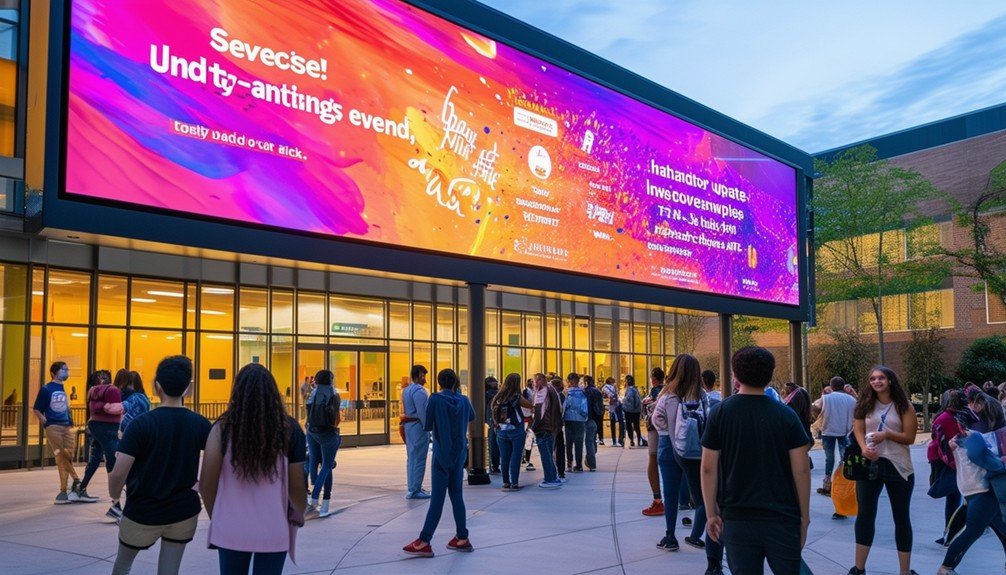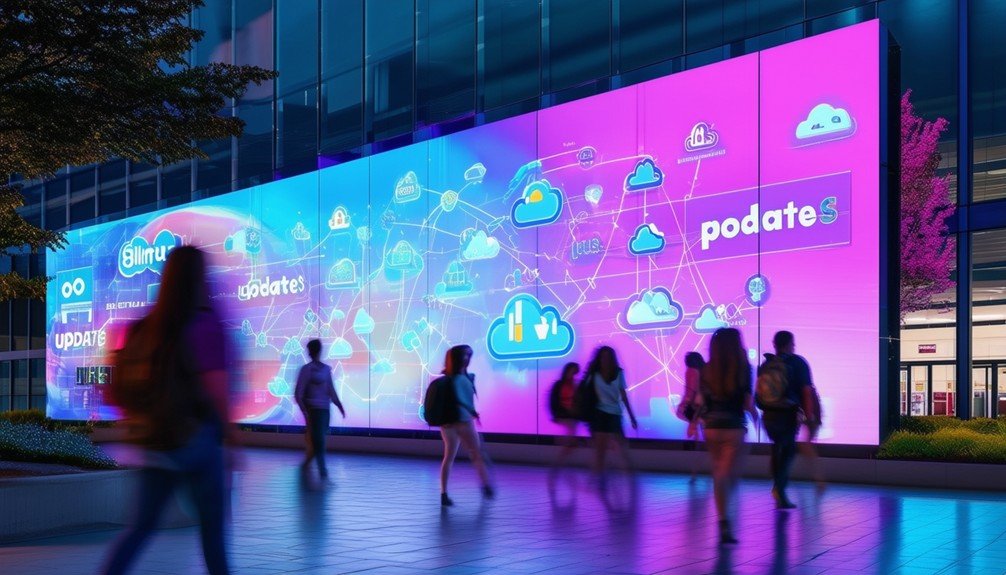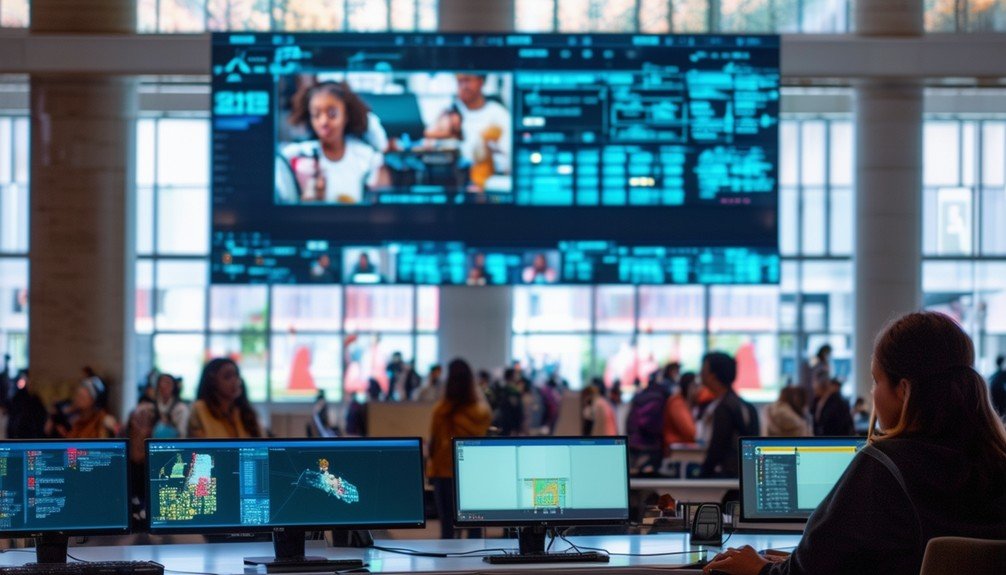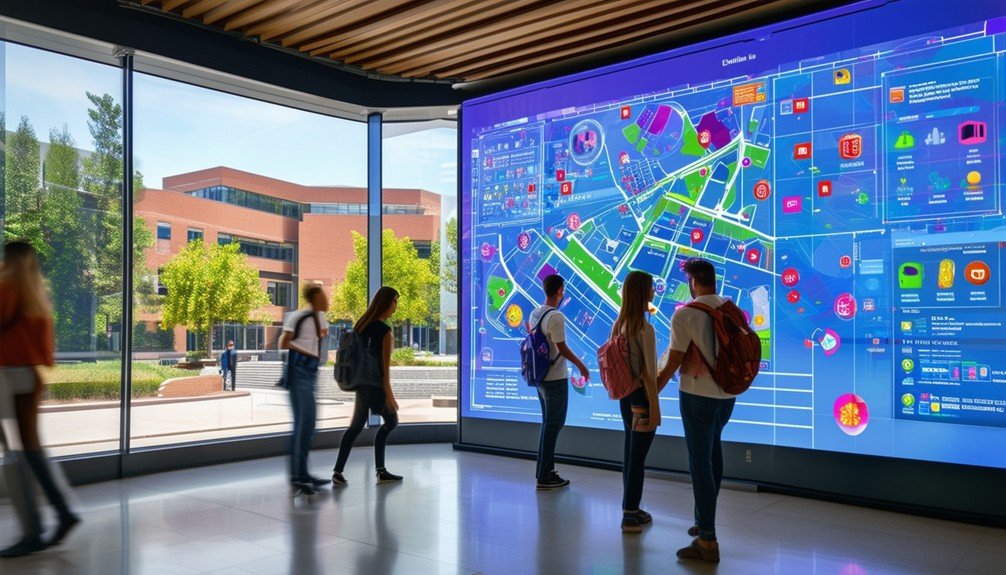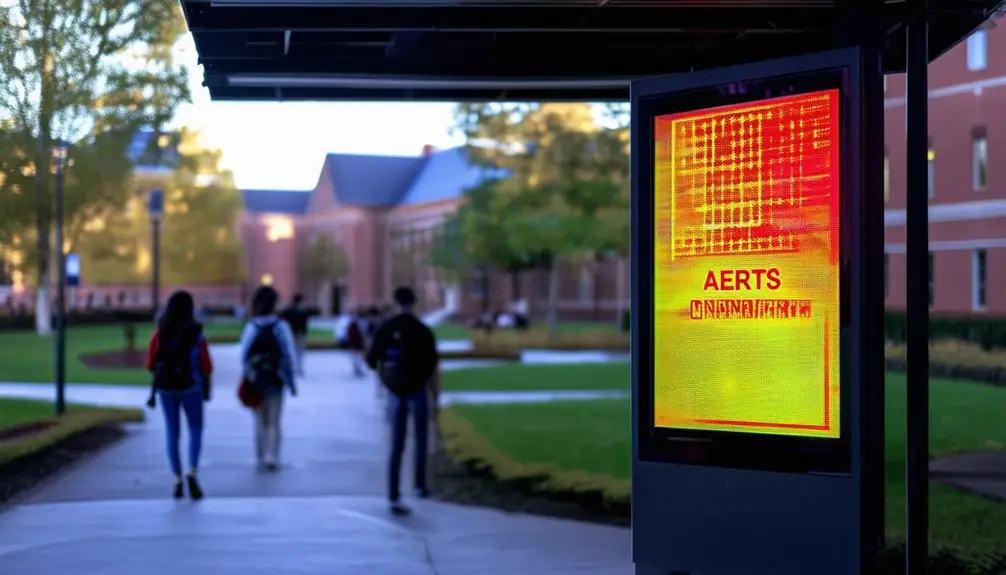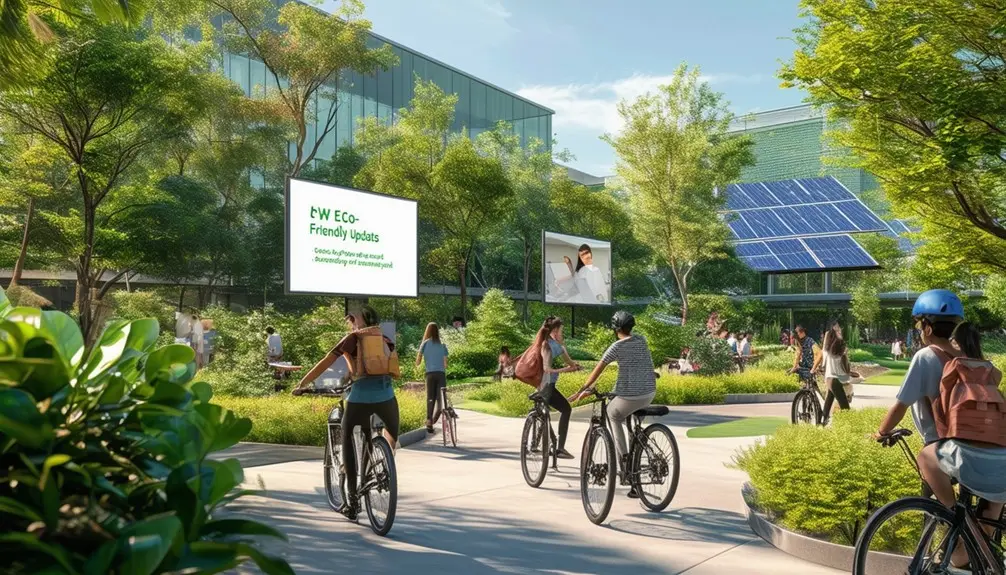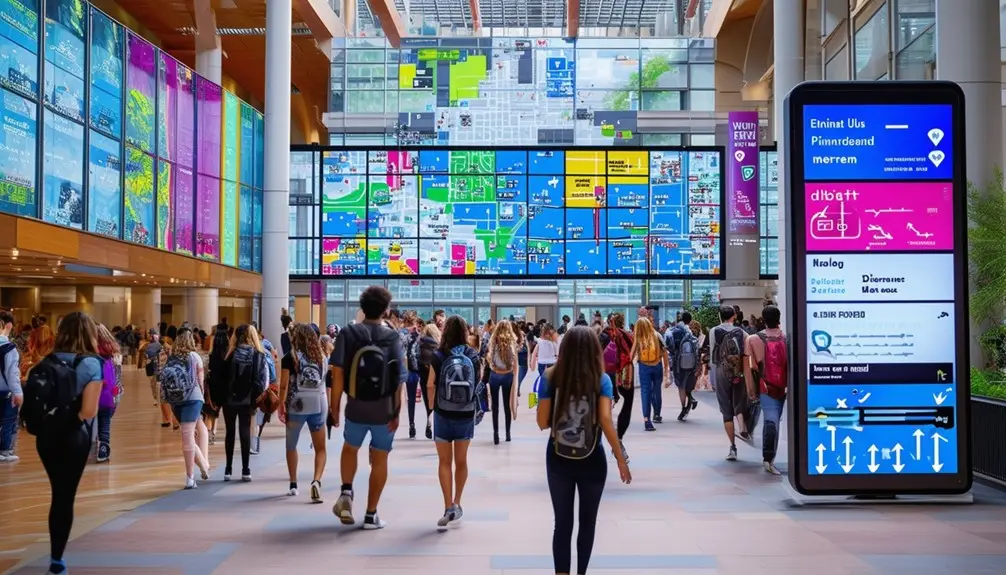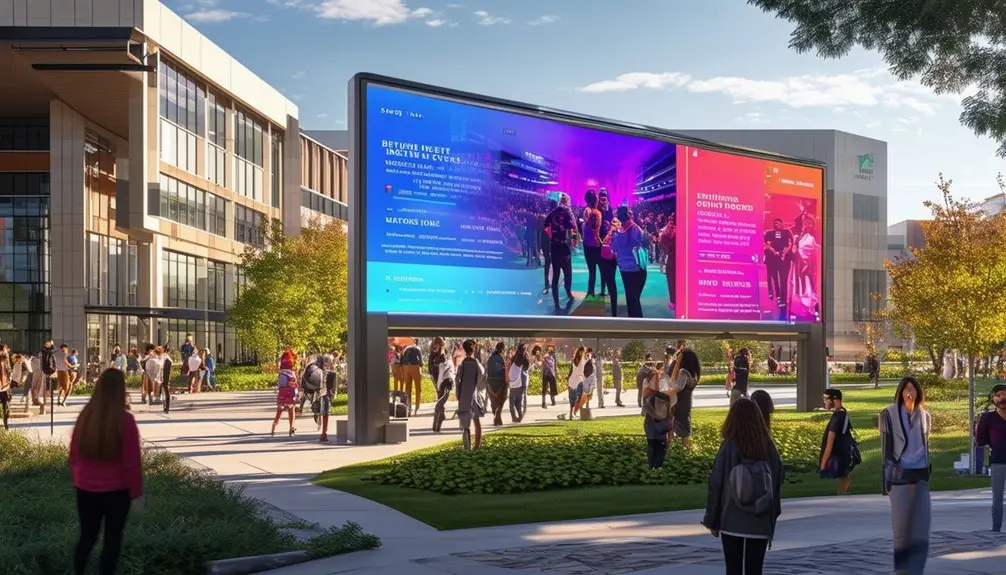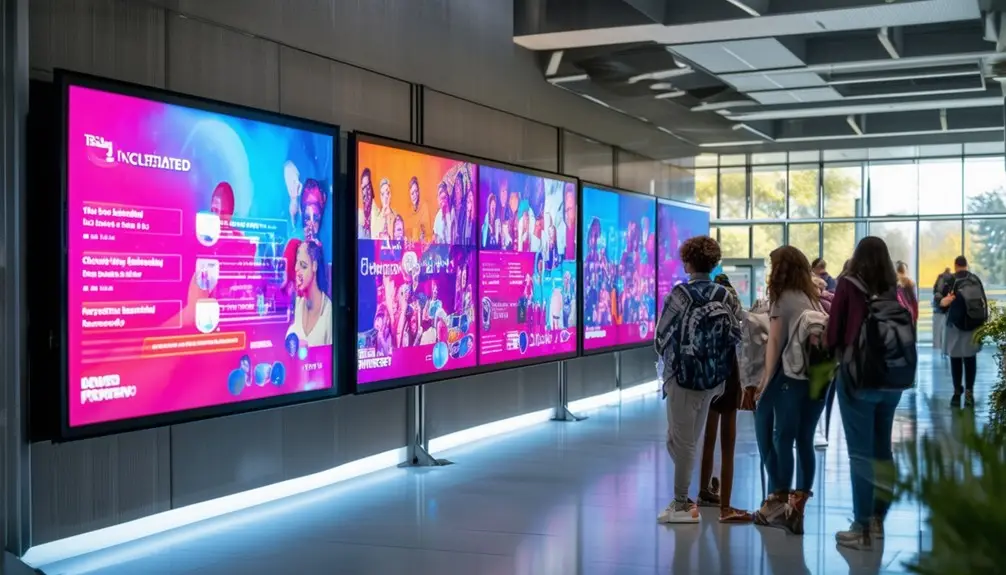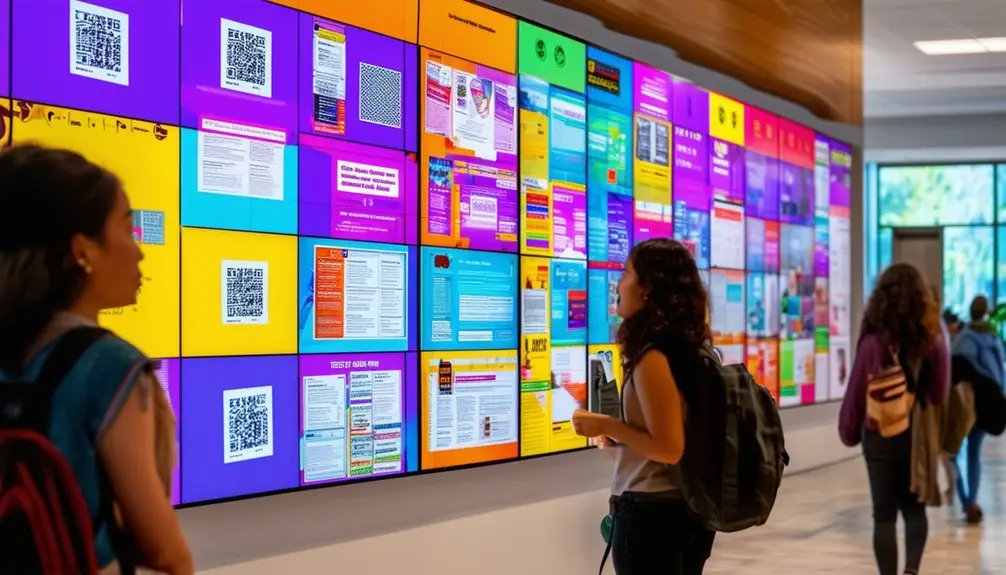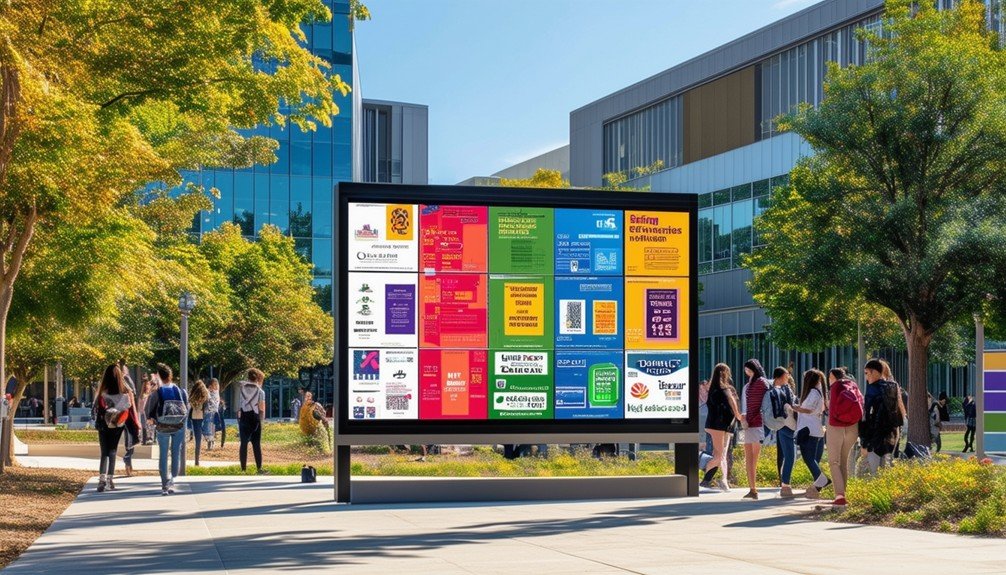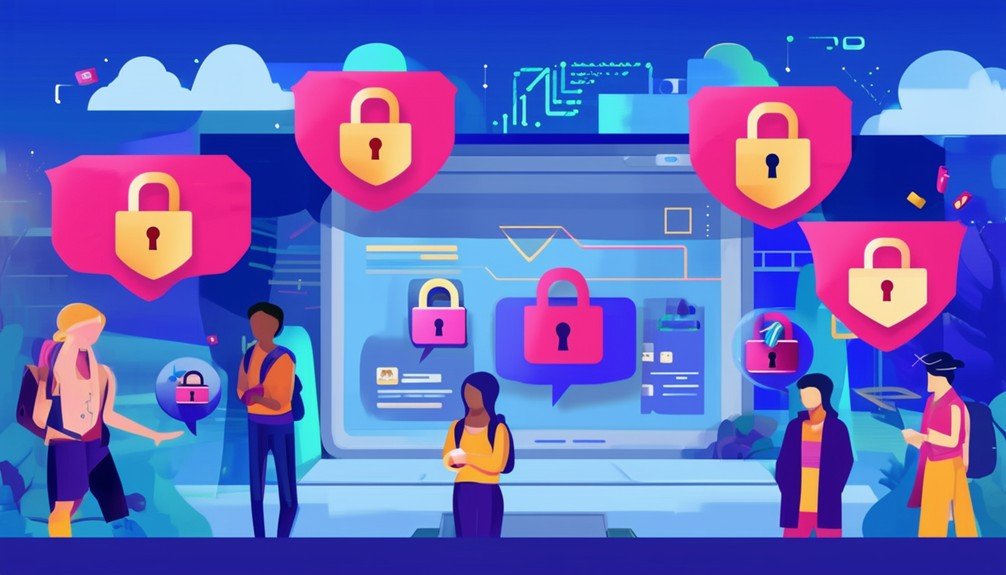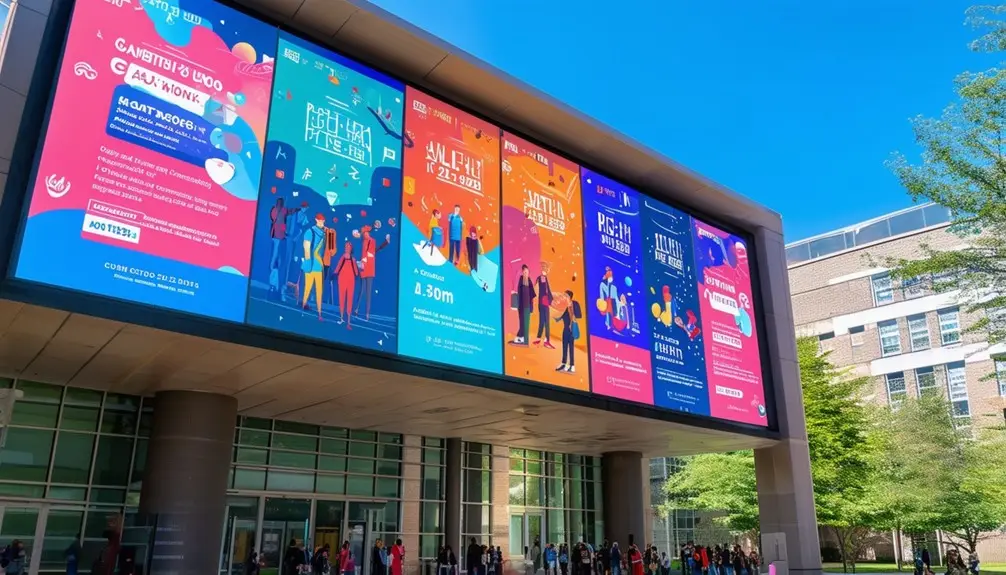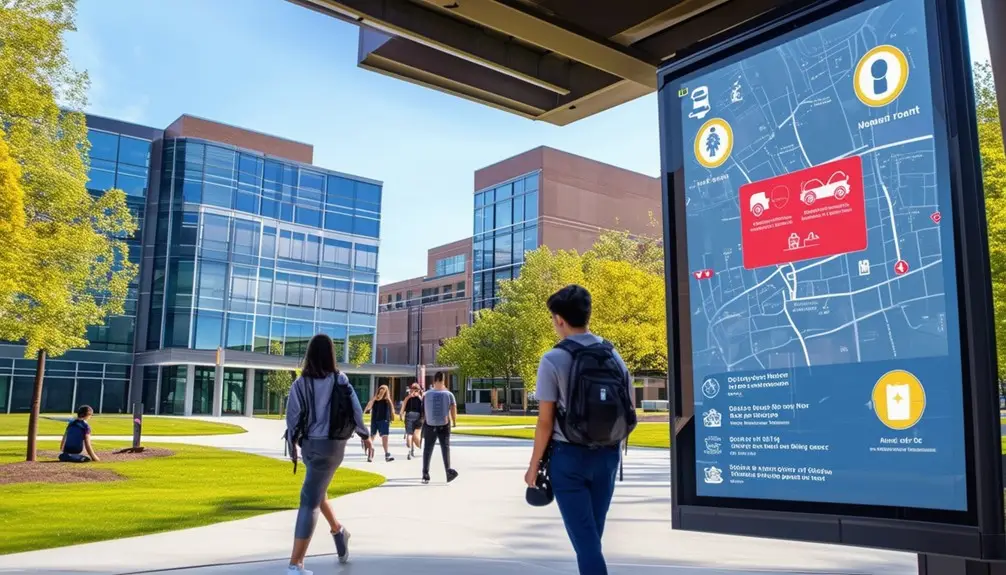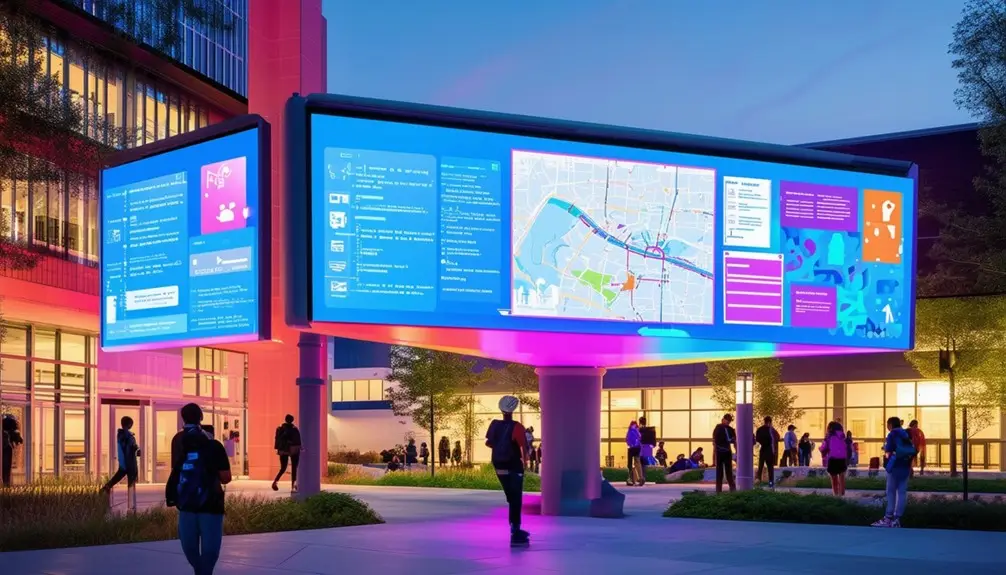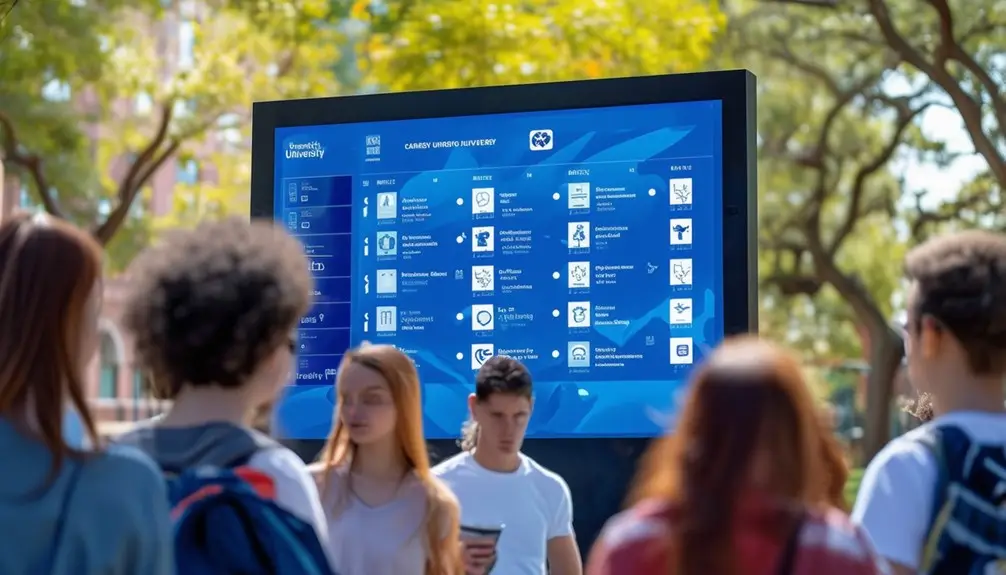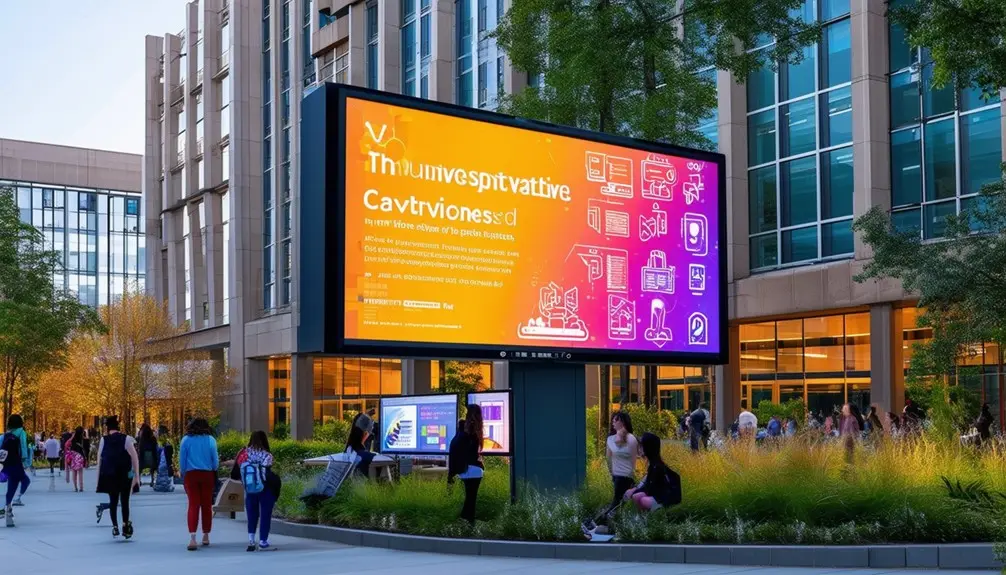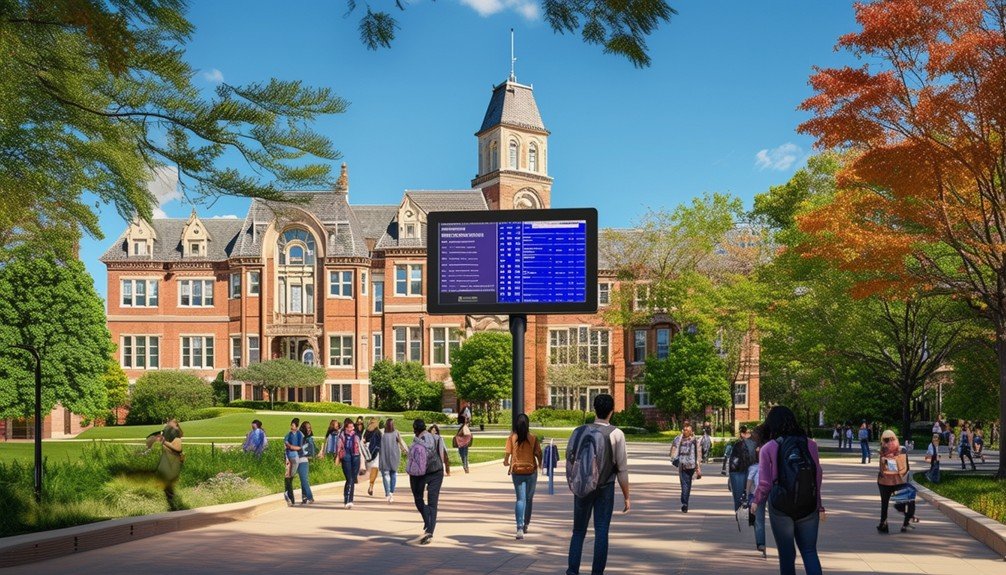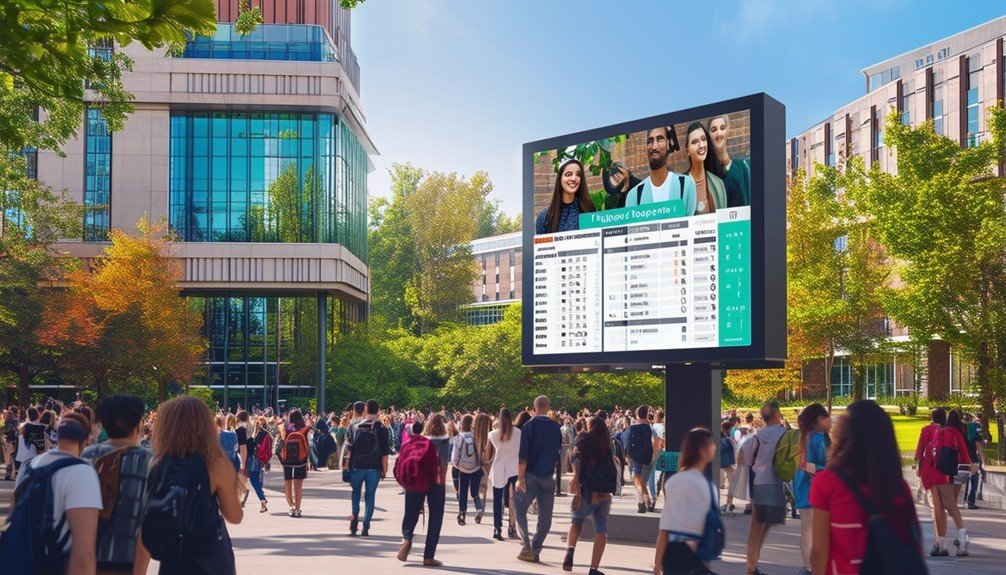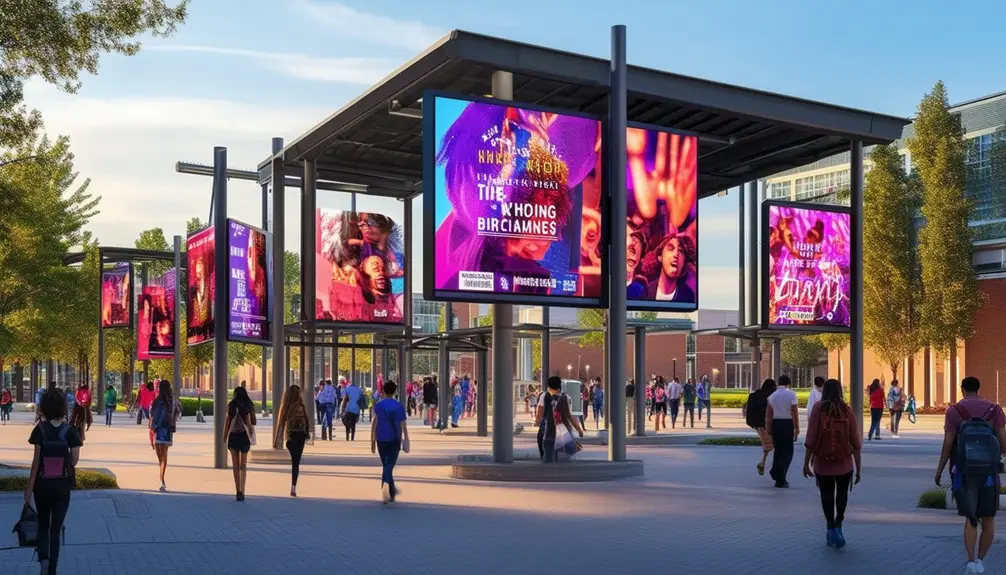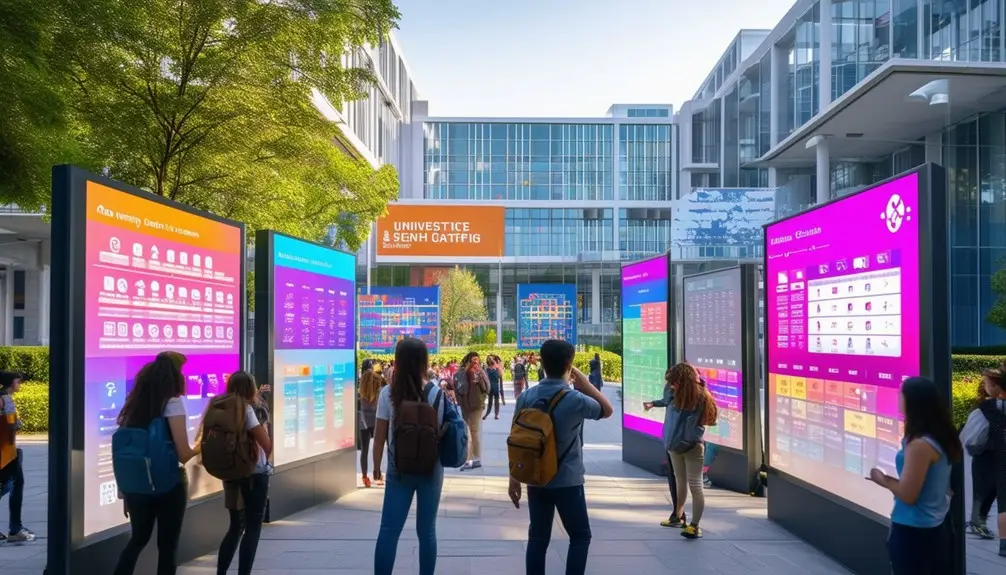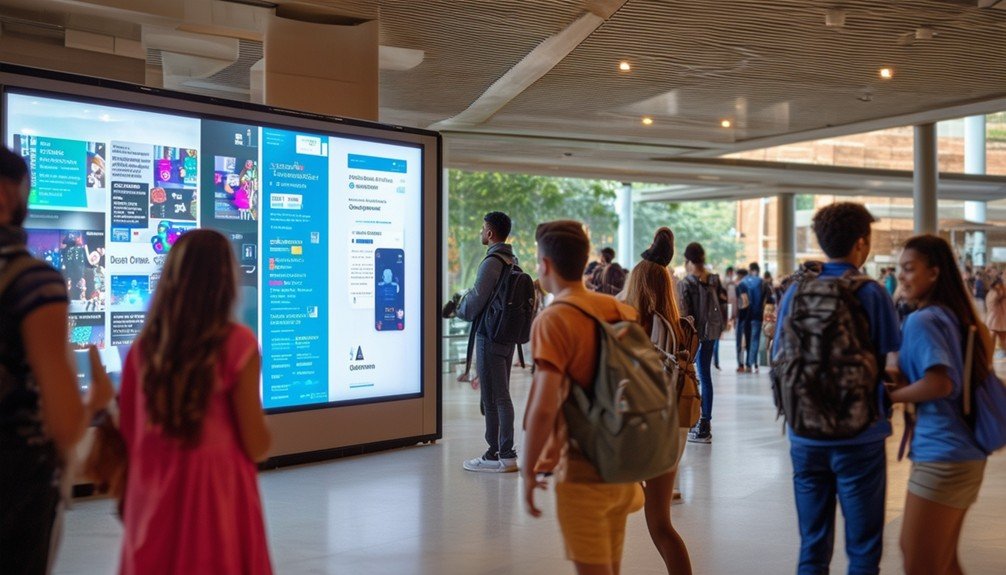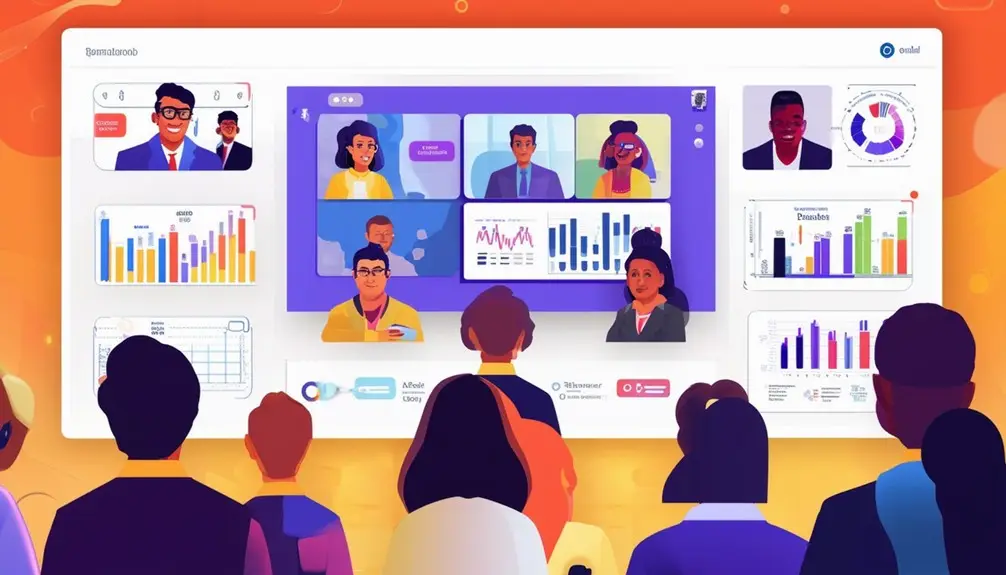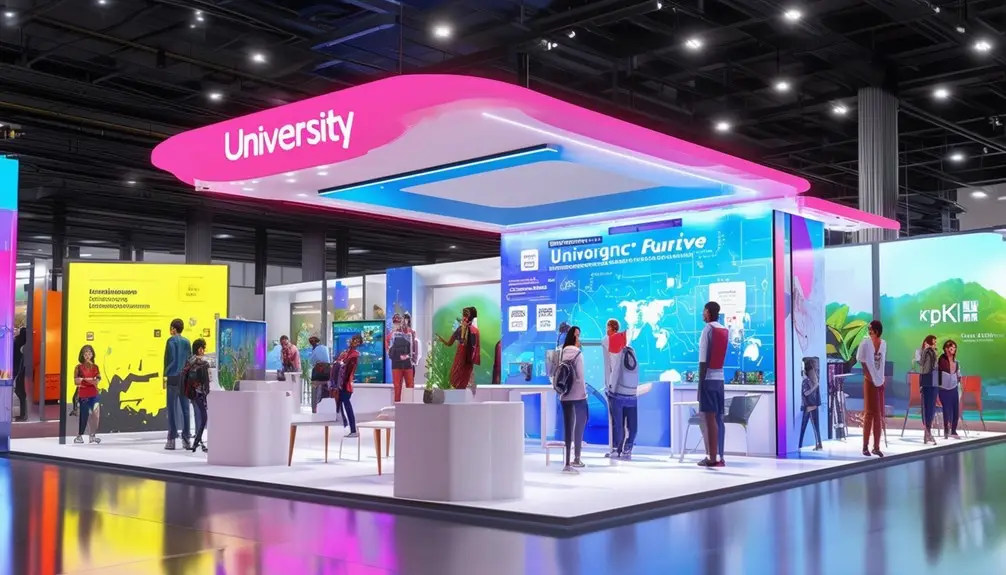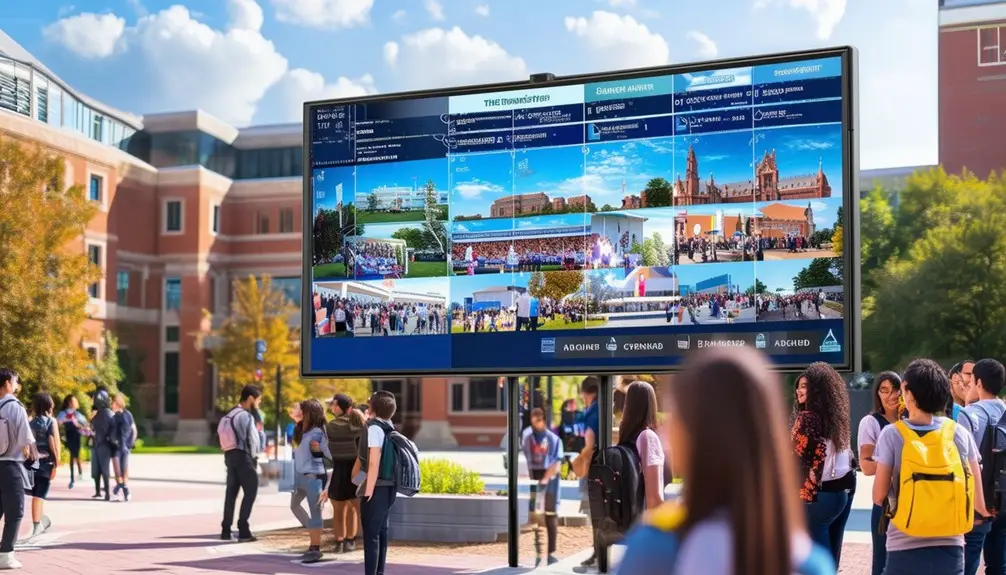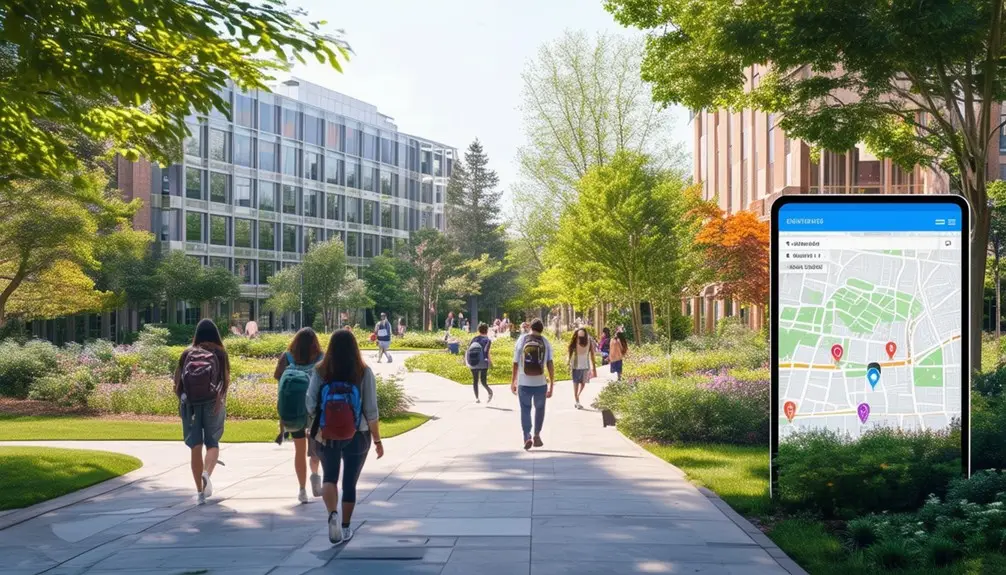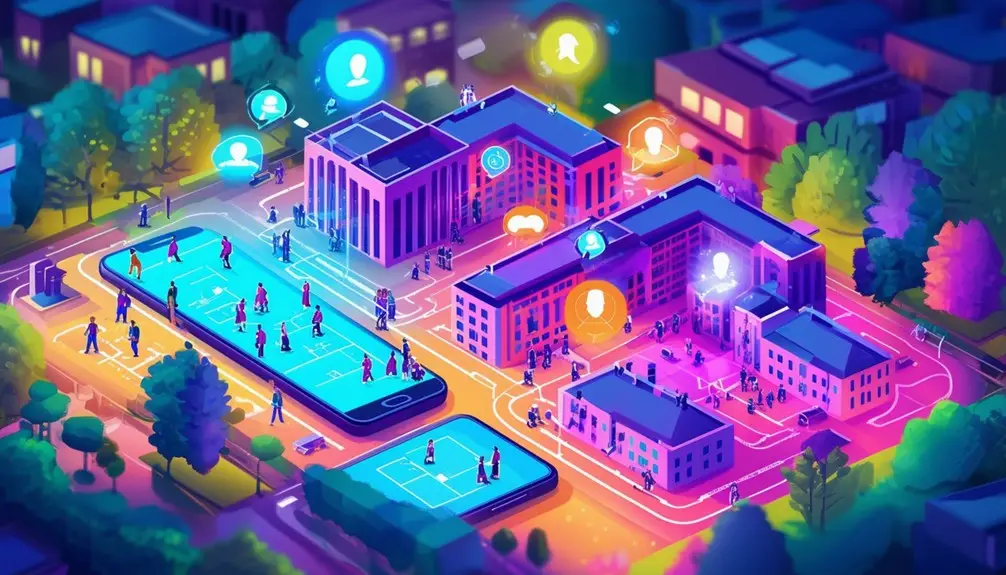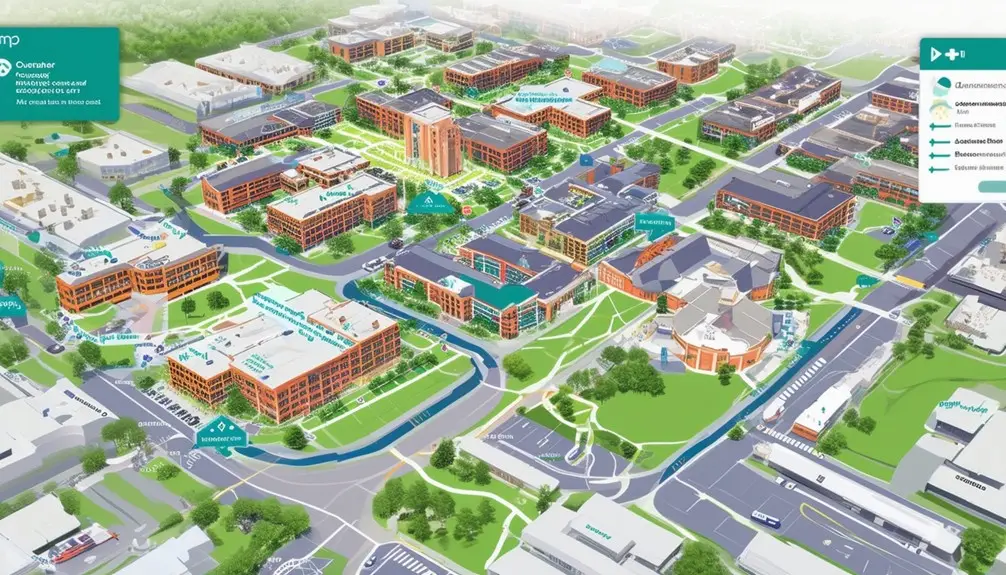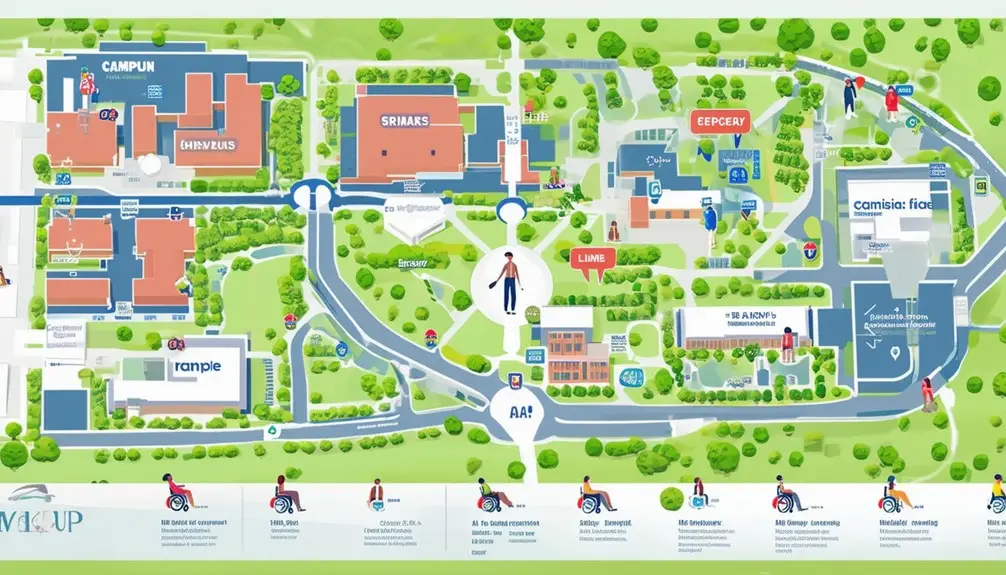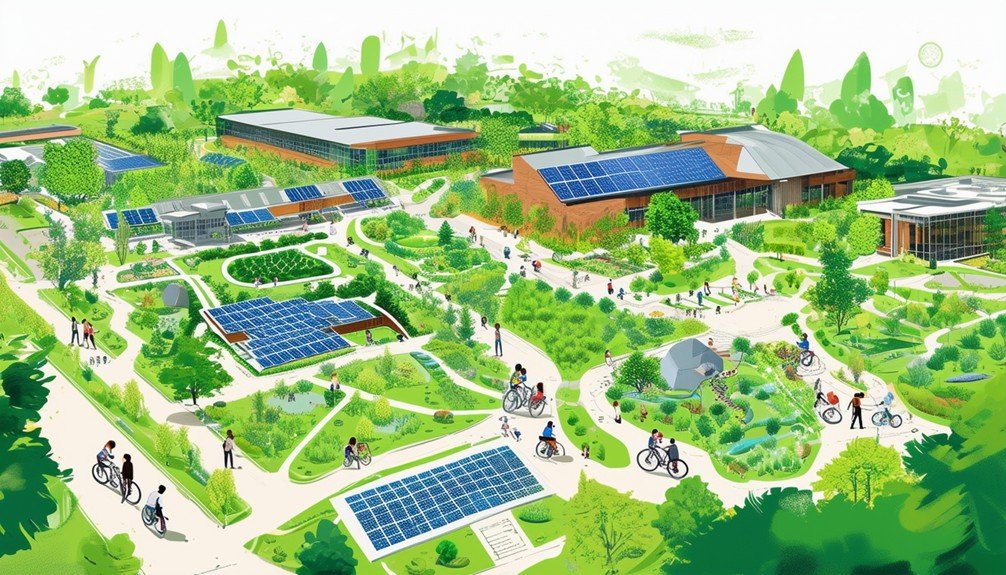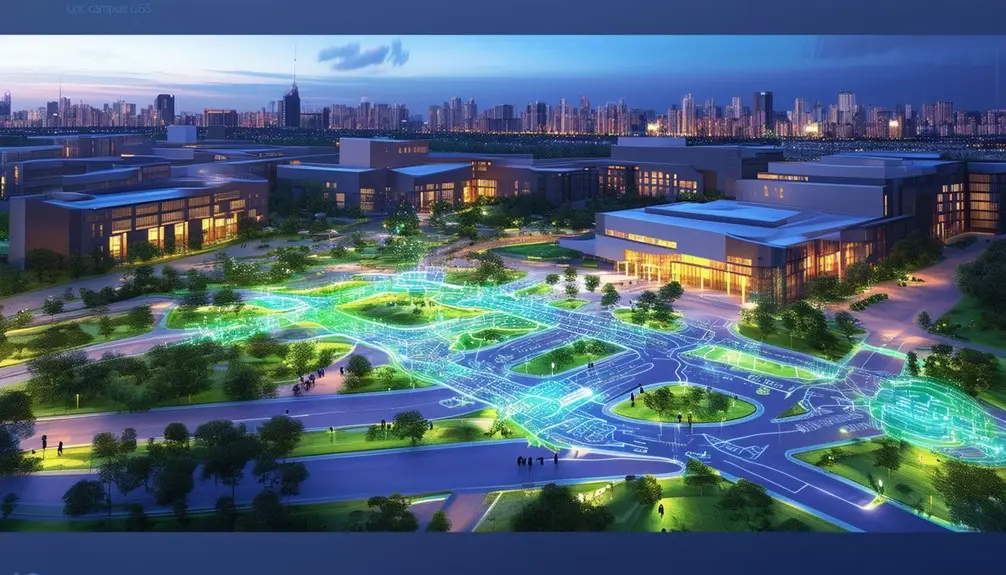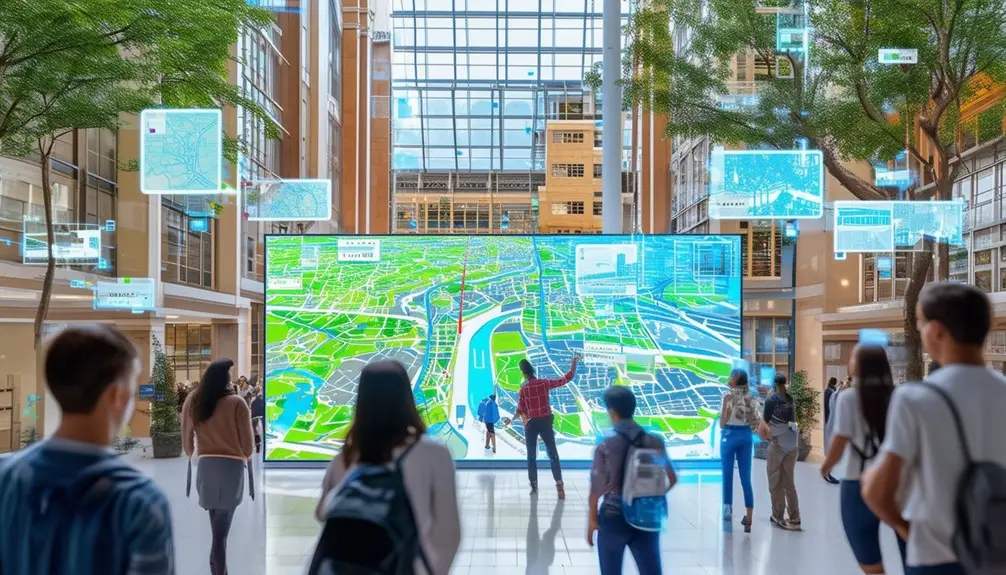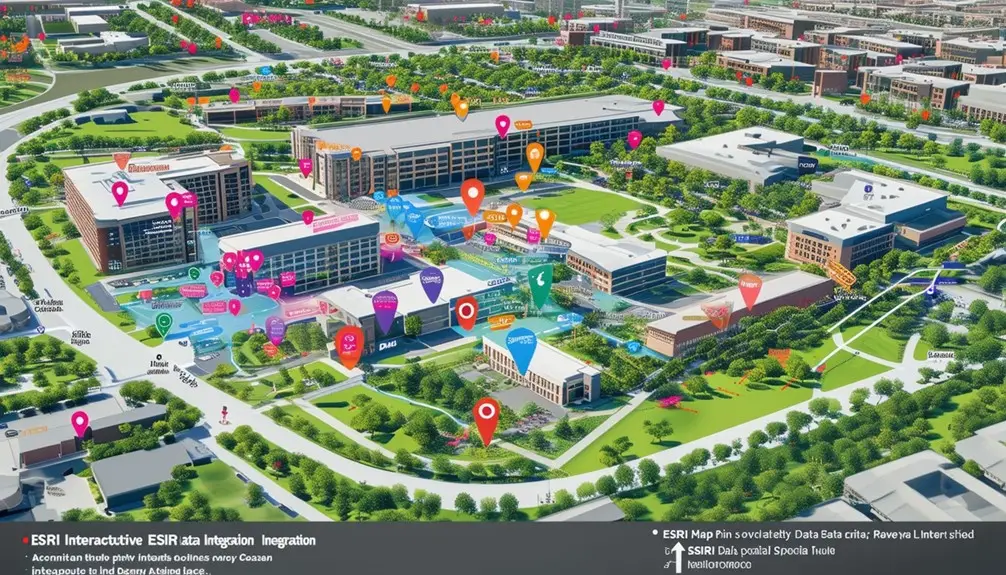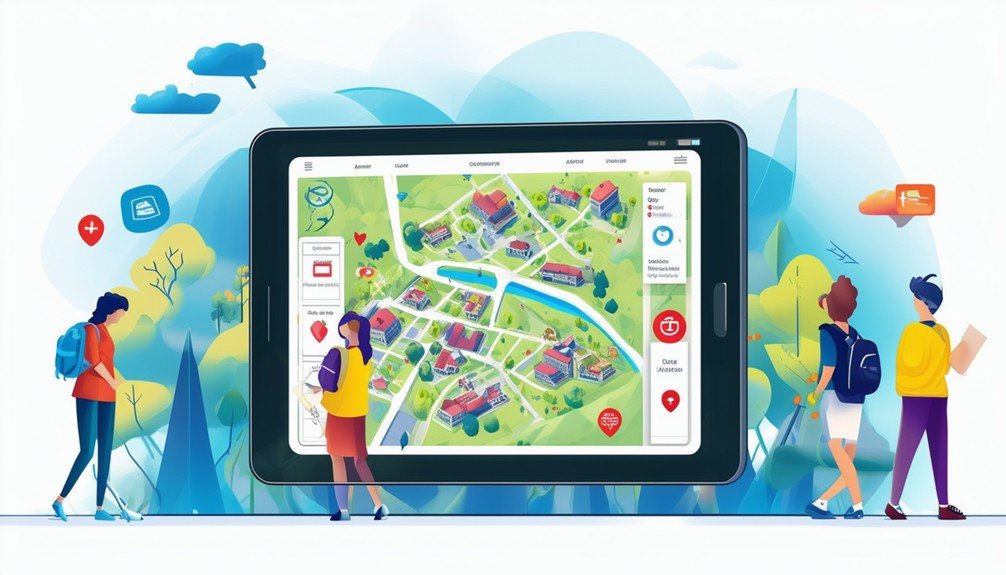Effective dining hall signage on college campuses helps you navigate menus, find operating hours, and explore daily food options. Check entrance signage or the university dining website for accurate hours, which can vary during holidays and special events. Signs often highlight diverse menu choices, including vegetarian and gluten-free options. Engaging signage encourages you to vote on future menu items, enhancing your dining experience. Social media platforms also provide real-time updates and feedback opportunities. Consistent branding through logos and color schemes guarantees easy recognition. Continue for more insights into maximizing your campus dining experience.
Key Takeaways
- Signage provides operating hours and locations of dining halls.
- Consistent branding on signage enhances recognition and conveys dining hall values.
- Signage includes clear labeling for special dietary needs like vegetarian, vegan, and gluten-free options.
- Real-time updates and detailed maps are accessible via the university dining website.
- Special events or extended hours are often indicated on entrance signage.
Operating Hours and Locations
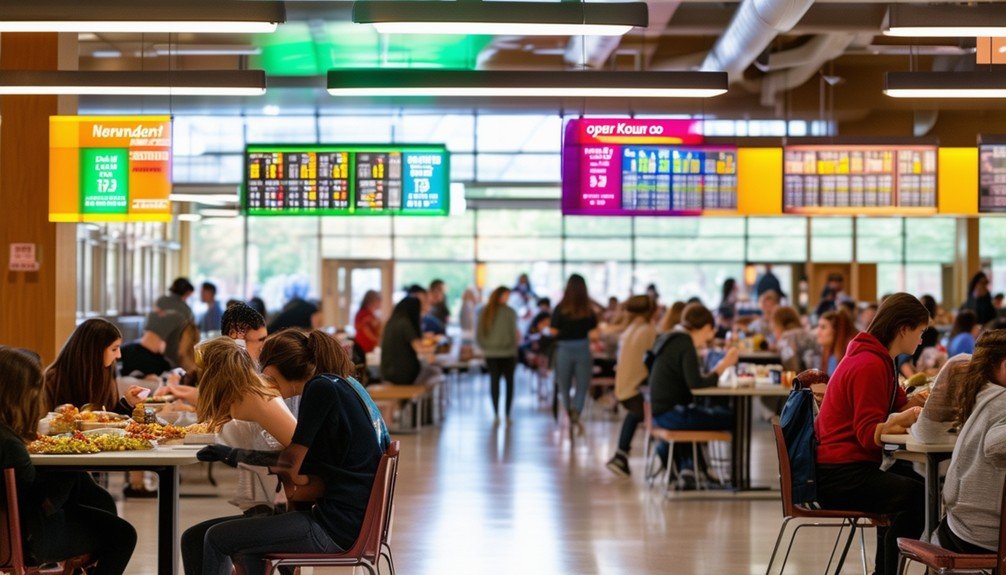
To discover the operating hours and locations of dining halls, check the entrance signage or the university dining website. At the University of Houston, dining halls are strategically positioned across campus, guaranteeing you have easy access no matter where you are. It’s crucial to stay updated, as operating hours can change due to special events or holidays. Always double-check the posted hours to avoid any inconvenience.
The university dining website is a reliable resource for real-time information. Here, you can find detailed maps and schedules for each dining hall. Additionally, the University of Houston offers a mobile app, making it even more convenient to check operating hours and locations on the go.
During exam periods or special occasions, some dining halls might extend their hours to better accommodate your busy schedule. These changes are typically posted well in advance, so keep an eye out for announcements both online and at the dining hall entrances. By staying informed, you can make sure you’re never caught off guard when planning your meals.
Daily Menu Options
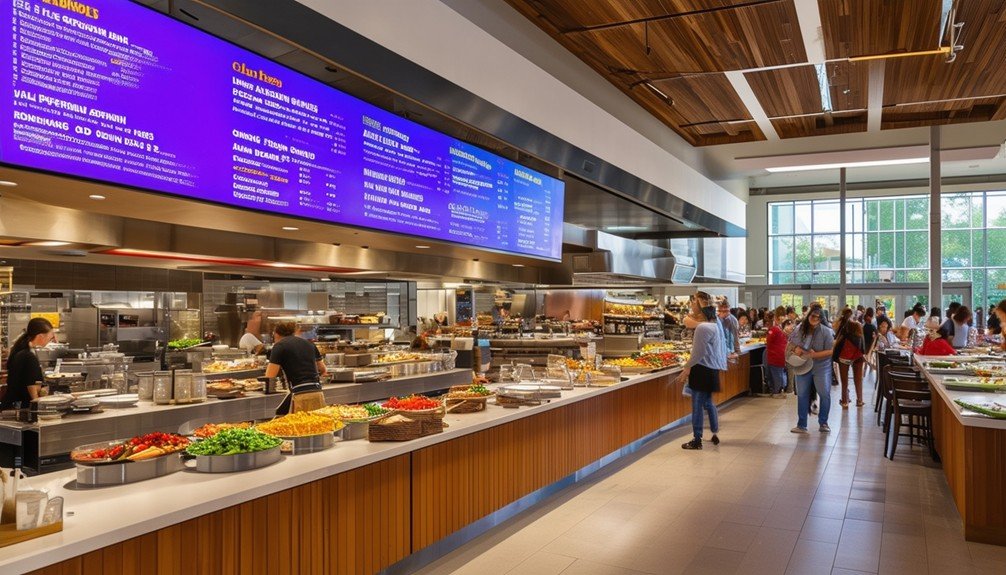
Daily menu options at the University of Houston dining halls provide a diverse array of choices for breakfast, lunch, and dinner, ensuring there’s something for everyone. You’ll find menus categorized by stations such as the grill, salad bar, and international cuisine, allowing you to explore various dishes each day. To help plan your meals, you can view the menus based on the time of day, ensuring you know what’s available whether you’re an early riser or a night owl.
The online menus are particularly handy, offering a convenient way for you to explore dining options and make informed choices. Menus are regularly updated to reflect current offerings and accommodate different dietary preferences, so you can easily find vegetarian, vegan, gluten-free, and other specialized options.
Here’s a sample of what you might see at the dining hall:
| Station | Sample Dish |
|---|---|
| Grill | Grilled Chicken |
| Salad Bar | Caesar Salad |
| International | Chicken Tikka Masala |
Voting on Dining Choices
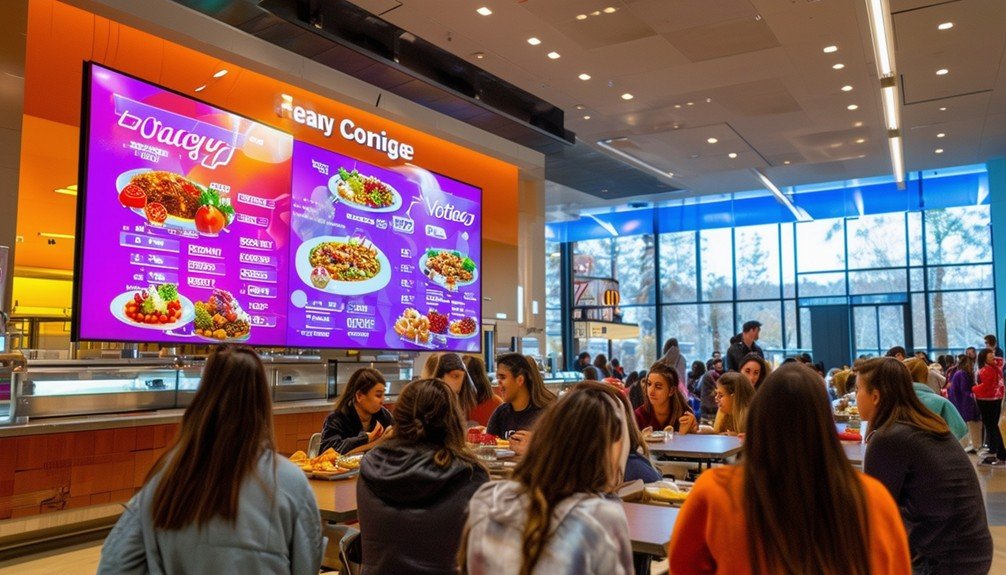
Beyond exploring daily menu options, you can actively shape your dining experience by participating in voting on dining choices. By engaging in this process, you’re given the chance to influence future menu selections and contribute to the decision-making process. It’s a unique opportunity to voice your preferences and make sure that your tastes are represented in the dining hall offerings.
Voting on dining choices promotes a sense of community and ownership over the dining options available. When you and your peers participate in voting activities, you help create a more personalized dining experience that reflects the diverse tastes of the student body. This involvement not only enhances your satisfaction but also fosters a stronger sense of belonging within the campus community.
Social Media Engagement
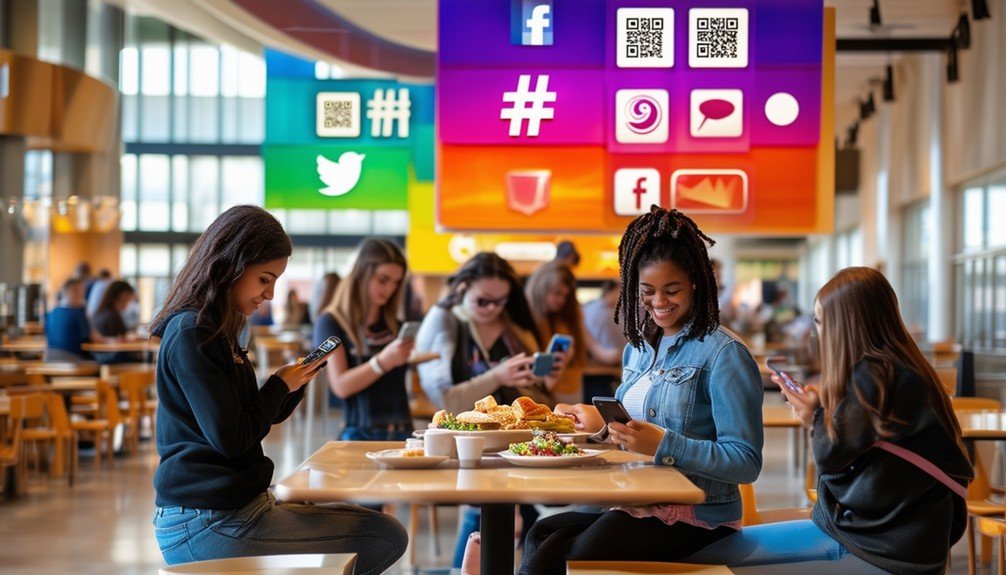
Engaging with students through social media platforms like Facebook and Instagram allows dining halls to share updates, promotions, and events directly with the campus community. When you connect with students on these platforms, you create a dynamic sense of community and foster more interaction. By posting about new menu items or limited-time offers, you can pique interest and drive more traffic to the dining hall.
Additionally, social media is a powerful tool for gathering feedback. Running polls or asking for comments on potential new dishes involves students in the decision-making process, making them feel valued and heard. This interactive approach not only boosts engagement but also ensures that the dining hall offerings align more closely with student preferences.
Behind-the-scenes glimpses into the kitchen or staff activities provide a more personal touch, helping to humanize the dining experience. These posts can make students feel more connected to the people who prepare their meals, thereby enhancing their overall dining experience.
Dining Hall Offerings
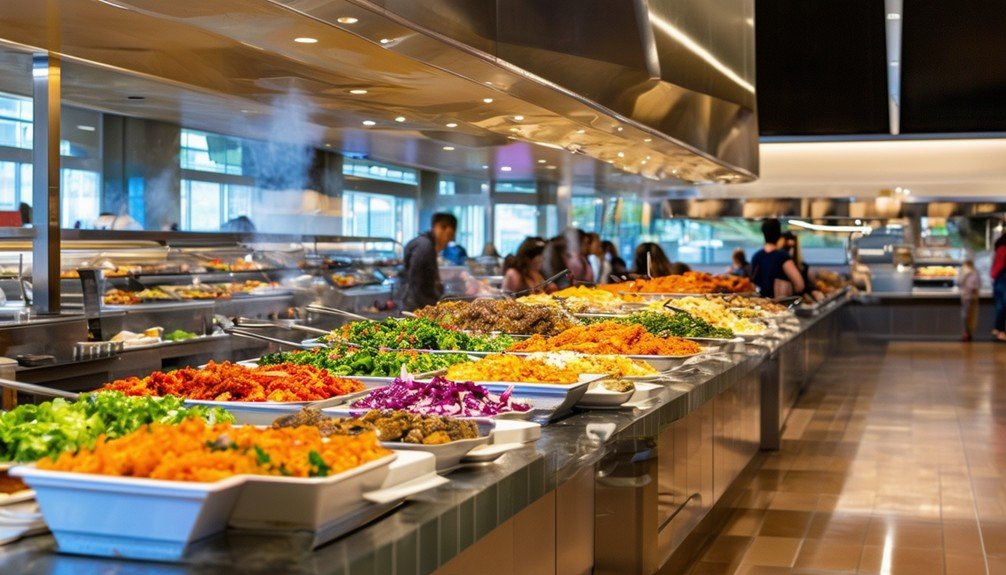
You’ll find a variety of dining options on campus, from popular chains like Starbucks and Chick-fil-A to a 24/7 dining commons. Menus are regularly updated online, letting you make informed choices that cater to your dietary needs and preferences. This flexibility not only supports your well-being but also enhances your overall campus experience.
Diverse Menu Options
University dining halls offer a range of menu options to meet the diverse dietary preferences and tastes of the student body. You’ll find a variety of vegetarian, vegan, and gluten-free choices, guaranteeing everyone can enjoy a satisfying meal. The menus feature a mix of traditional comfort foods and international dishes, catering to a wide range of palates.
Healthy options are plentiful, with salads, grilled proteins, and fresh fruits integrated into daily offerings. Dining halls also keep things interesting by periodically updating their menus. New items, seasonal specialties, and student favorites are introduced based on feedback and preferences, keeping the dining experience dynamic and engaging.
Here’s a sample of the diverse menu options you might encounter:
| Cuisine Type | Sample Dish |
|---|---|
| Traditional Comfort | Macaroni and Cheese |
| International | Chicken Tikka Masala |
| Vegetarian | Quinoa and Veggie Stir-Fry |
| Vegan | Lentil Soup |
This variety not only ensures nutritional balance but also makes mealtime an opportunity to explore new flavors and cuisines. University dining halls aim to create an inclusive environment where every student can find something delicious and wholesome to eat.
Special Dietary Needs
In addition to offering diverse menu options, dining halls also cater to students with special dietary needs through clearly labeled stations and menu items. If you’re following a gluten-free, vegetarian, or vegan diet, finding suitable meals is straightforward thanks to these clear labels. Allergen information on signage helps you make informed choices, ensuring you avoid ingredients that could trigger sensitivities or allergies.
Dining halls often collaborate with nutritionists or dietary experts to create menus that meet your nutritional requirements. These menus aren’t static; they rotate daily or weekly to keep your options varied and satisfying. You’ll appreciate the effort put into offering a wide range of dishes that address your specific needs.
To help you navigate these options, here are three key features to look for in dining hall signage:
- Dietary Labels: Clearly marked stations or items indicating gluten-free, vegetarian, and vegan options.
- Allergen Information: Signs that detail common allergens present in dishes to help you avoid adverse reactions.
- Menu Rotation: Regularly updated menus that provide diverse and nutritious options to prevent monotony.
Flexible Meal Plans
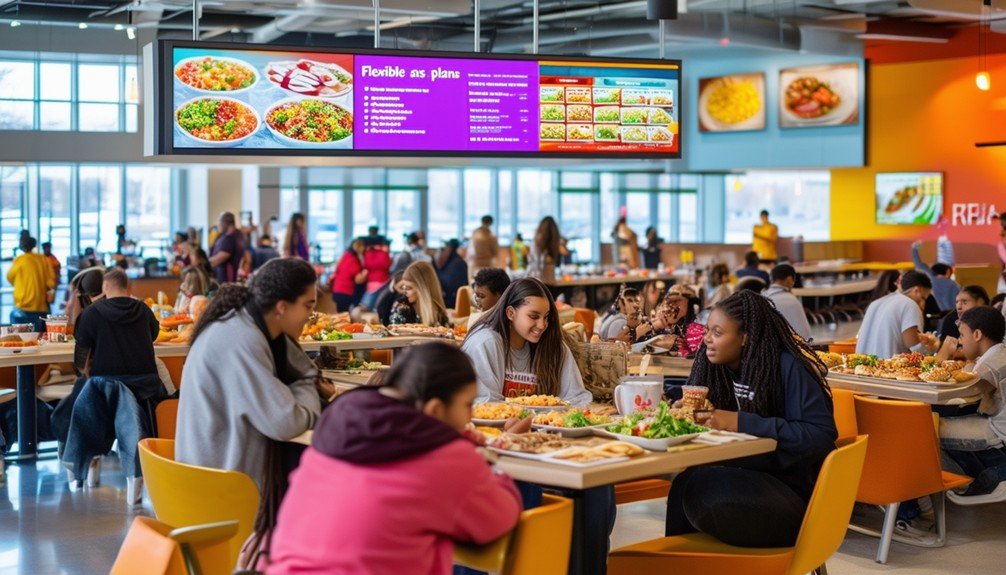
Flexible meal plans provide students the freedom to choose between unlimited access or block meal selections that suit their unique dining needs. With these options, you can determine what aligns best with your schedule and eating habits. Whether you prefer the convenience of unlimited meals or the structure of a block plan, there’s a solution that caters to your lifestyle.
Declining balance plans are another flexible option, offering you greater control over your dining budget. These plans operate like a prepaid debit card, allowing you to use your allocated funds as you deem appropriate. This flexibility ensures you can grab a quick snack or enjoy a full meal whenever you need it without concerns about depleting meals.
Cougar Cash adds an extra layer of convenience, usable across various dining locations on campus. This system guarantees you have access to a wide range of dining choices, from coffee shops to full-scale dining halls.
Flexible meal plans are designed to meet diverse dietary needs, making it easier to adhere to specific eating habits. By enhancing your dining options, these plans help provide you with a personalized and satisfying dining experience on campus.
Visual Identity and Branding
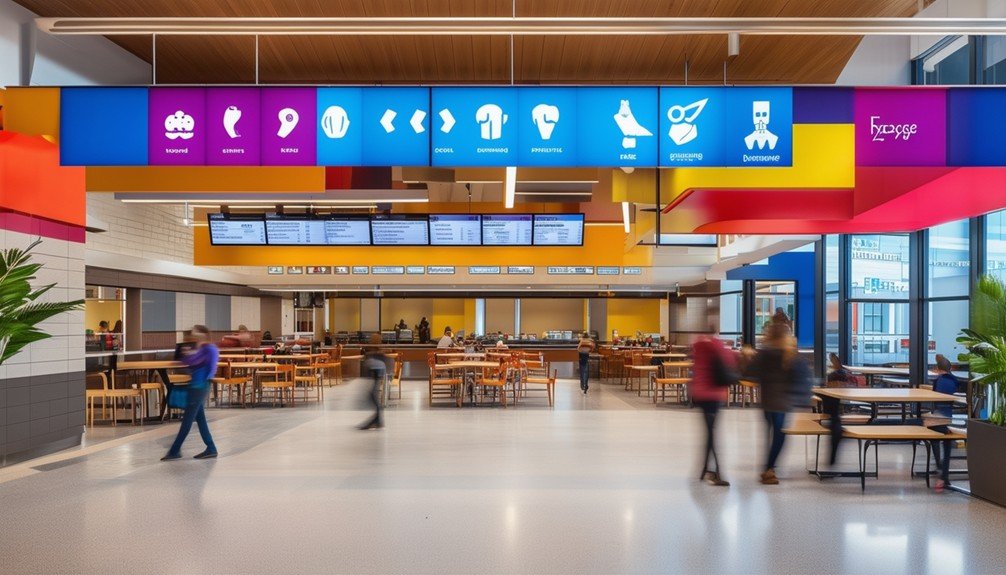
To improve your dining experience further, the visual identity and branding of dining hall signage play an important role in creating a cohesive and recognizable atmosphere. Consistent branding across all dining hall touchpoints not only enhances recognition but also reinforces the core values of the dining hall. By focusing on logos, colors, typography, and messaging, a well-defined visual identity helps communicate the dining hall’s personality and values to students and visitors.
Visual elements like logos and color schemes are vital in building trust and credibility. When you see familiar and well-designed signage, you’re more likely to feel confident about the dining choices available. Effective branding sets your dining hall apart from competitors and establishes a memorable brand image.
Here are three key components to bear in mind:
- Logos and Color Schemes: These elements should be instantly recognizable and aligned with the overall brand identity, creating a sense of trust and familiarity.
- Typography and Messaging: Consistent use of fonts and clear, concise messaging enhances readability and reinforces brand values.
- Brand Consistency: Ensure that all visual elements are uniform across various platforms, from physical signage to digital menus, to maintain a cohesive brand image.
Calorie Count Controversy
Calorie counts posted in Northwestern dining halls have sparked debate due to their potential to trigger stress and unhealthy eating habits among students. When you see those numbers, it can be hard to ignore them, possibly leading to an unhealthy obsession with calorie tracking. For some, this constant focus on calories can exacerbate or even contribute to disordered eating habits.
The accuracy of these calorie counts can be questionable. Occasional typos and inconsistencies mean that the information you’re relying on might not always be correct. This can create confusion and potentially lead to misguided dietary choices.
Not everyone finds calorie labels necessary. While they can be useful for those who need or want to track their intake, they’re not beneficial for everyone. A possible solution is to place calorie information on a separate website. This way, you can choose whether to look up the information, reducing the pressure during meal times.
Conclusion
To sum up, improving college campus dining hall signage involves clear operating hours, daily menu options, and interactive voting on dining choices. Engage students through social media, highlight diverse offerings, and provide flexible meal plans. Guarantee consistent visual identity and address calorie count controversies transparently. By doing so, you’ll create a dining experience that’s not just functional but futuristic, like a real-life tricorder scanning your food choices. Effective signage turns mealtime into a seamless, enjoyable part of student life.
Frequently Asked Questions
How Can I Improve My College Dining Hall?
You can enhance your college dining hall by implementing clear, color-coded signage, using digital menu boards for real-time updates, and incorporating interactive signs. Guarantee allergen information and dietary restrictions are prominently displayed for student safety.

